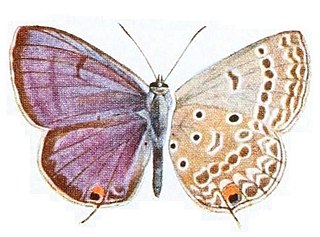Camponotus maculatus is a species of carpenter ant (genus Camponotus ).
Camponotus maculatus is a species of carpenter ant (genus Camponotus ).

Honeypot ants, also called honey ants, are ants which have specialized workers that consume large amounts of food to the point that their abdomens swell enormously. Other ants then extract nourishment from them, through the process of trophallaxis. They function as living larders. Honeypot ants belong to any of several genera, including Myrmecocystus and Camponotus. They were first documented in 1881 by Henry C. McCook, and described further in 1908 by William Morton Wheeler.

Carpenter ants are large ants indigenous to many forested parts of the world.

Myrmecophila is a genus of plants belonging to the family Orchidaceae. It is native to southern Mexico, Central America, the West Indies and Venezuela.

Camponotus atriceps, previously referred as C. abdominalis, is a species of carpenter ant, endemic to the Americas.

Axiocerses amanga, the bush scarlet, is a butterfly of the family Lycaenidae. It is found in Sub-Saharan Africa.

Lepidochrysops methymna, the monkey blue, is a butterfly of the family Lycaenidae. It is found in South Africa.

Lepidochrysops patricia, the patrician blue, is a butterfly of the family Lycaenidae. It is found in South Africa, from the Western Cape to the Eastern Cape and to KwaZulu-Natal, the Free State, Gauteng, Mpumalanga, Limpopo, the North West and the Northern Cape.
Lepidochrysops glauca, the Rossouw's blue, is a butterfly of the family Lycaenidae. It is found in South Africa, where it is restricted to grassy escarpments near the Stoffberg, Dullstroom and Lydenburg in Mpumalanga.

Lepidochrysops trimeni, the Trimen's blue, is a butterfly of the family Lycaenidae. It is found in South Africa, where it is known from the Western Cape.

Lepidochrysops quassi, the tailed blue giant Cupid, is a butterfly in the family Lycaenidae. It is found in Ivory Coast, Ghana, Togo, Nigeria and Cameroon. Its habitat consists of open areas in the forest zone.

Camponotus japonicus, commonly known as the Japanese carpenter ant, is a species of ant native to eastern Asia. It is black, and one of the largest ants. A nest has about ten to thousands of individuals, and it can be a pest when it enters households or protects aphids. There are several subspecies of this ant in different areas of Asia, with the largest of the species being located in northern China.

Anthene larydas, the spotted hairtail or common ciliate blue, is a butterfly in the family Lycaenidae. It is found in Senegal, the Gambia, Guinea-Bissau, Guinea, Burkina Faso, Liberia, Sierra Leone, Ivory Coast, Ghana, Nigeria, Cameroon, the Republic of the Congo, the Central African Republic, the Democratic Republic of the Congo, Uganda, western Kenya to South Africa and Mozambique.
Camponotus irritans is a species of carpenter ant. It is found in many Asian and Oceanian countries.

Camponotus rufoglaucus is a species of carpenter ant. It is found from many Afrotropical, Indo-Australian, Oriental, Palaearctic regional countries.
Camponotus reticulatus is a species of carpenter ant. It is found from many Afrotropical, Indo-Australian, Oriental, Palaearctic regional countries and in Singapore.
Camponotus thraso is a species of carpenter ant. The type species is found from Sri Lanka.

Camponotus variegatus is a species of carpenter ant.

Camponotus niveosetosus, commonly known as the hairy sugar ant, is one of the smaller species of sugar ant. It is native to an extensive region in the eastern Afrotropics.